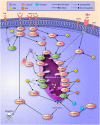Mechanisms of HIV-associated lymphocyte apoptosis: 2010
- PMID: 21368875
- PMCID: PMC3032328
- DOI: 10.1038/cddis.2010.77
Mechanisms of HIV-associated lymphocyte apoptosis: 2010
Abstract
The inevitable decline of CD4T cells in untreated infection with the Human immunodeficiency virus (HIV) is due in large part to apoptosis, one type of programmed cell death. There is accumulating evidence that the accelerated apoptosis of CD4T cells in HIV infection is multifactorial, with direct viral cytotoxicity, signaling events triggered by viral proteins and aberrant immune activation adding to normal immune defense mechanisms to contribute to this phenomenon. Current antiviral treatment strategies generally lead to reduced apoptosis, but this approach may come at the cost of preserving latent viral reservoirs. It is the purpose of this review to provide an update on the current understanding of the role and mechanisms of accelerated apoptosis of T cells in the immunopathogenesis of HIV infection, and to highlight potential ways in which this seemingly deleterious process could be harnessed to not just control, but treat HIV infection.
Figures


References
-
- Diaz M, Douek DC, Valdez H, Hill BJ, Peterson D, Sanne I, et al. T cells containing T cell receptor excision circles are inversely related to HIV replication and are selectively and rapidly released into circulation with antiretroviral treatment. Aids. 2003;17:1145–1149. - PubMed
-
- Dion ML, Poulin JF, Bordi R, Sylvestre M, Corsini R, Kettaf N, et al. HIV infection rapidly induces and maintains a substantial suppression of thymocyte proliferation. Immunity. 2004;21:757–768. - PubMed
-
- Rothen M, Gratzl S, Hirsch HH, Moroni C. Apoptosis in HIV-infected individuals is an early marker occurring independently of high viremia. AIDS Res Hum Retroviruses. 1997;13:771–779. - PubMed
-
- Finkel TH, Tudor-Williams G, Banda NK, Cotton MF, Curiel T, Monks C, et al. Apoptosis occurs predominantly in bystander cells and not in productively infected cells of HIV- and SIV-infected lymph nodes. Nat Med. 1995;1:129–134. - PubMed
-
- Wang L, Chen JJ, Gelman BB, Konig R, Cloyd MW. A novel mechanism of CD4 lymphocyte depletion involves effects of HIV on resting lymphocytes: induction of lymph node homing and apoptosis upon secondary signaling through homing receptors. J Immunol. 1999;162:268–276. - PubMed
Publication types
MeSH terms
Substances
Grants and funding
LinkOut - more resources
Full Text Sources
Other Literature Sources
Medical

